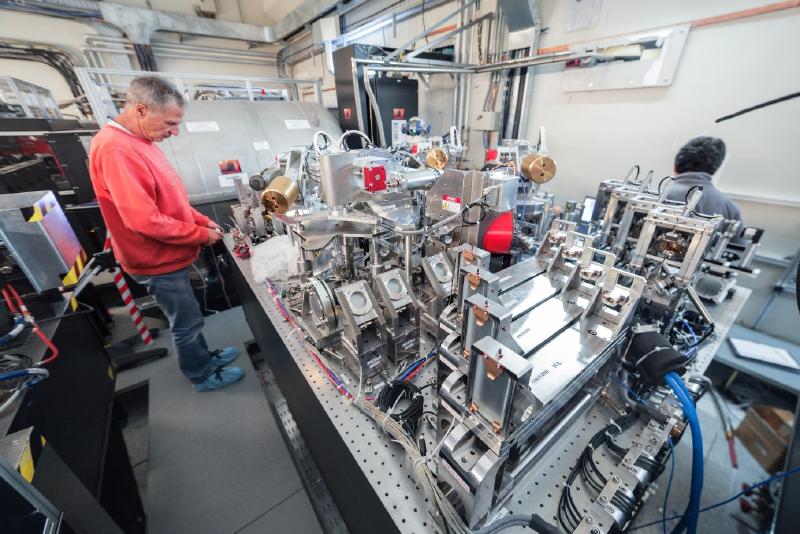Académie d'Excellence "Espace, Environnement, Risques et Résilience"
Center for Planetary Origin
Our Solar System is not the typical planetary system: when new spatial discoveries make us to develop a new multi-disciplinary approach to planet formation

Academy 3 highlight
C4PO builds a multidisciplinary synergy among planetary science, geophysics and material science to improve our understanding of the formation of planets and planetary systems, including the Earth and the Solar System.
The project
The discovery of extrasolar planetary systems has revealed a great diversity of orbital architectures and physical properties of planets in the galaxy. In particular, it has been found that most stars have planets that have different orbital or physical properties from the planets in our own system. Therefore, our Solar System is not the typical planetary system. Consequently, the models of planet formation developed in the twentieth century, with the underlying principle that other planetary systems are similar to our own, are now invalidated. This calls for the urgent need to develop new models that can explain the observed diversity of systems and help us to understand our Solar System as one of the possible end-states that would have resulted from complex formation/evolution processes. The Center for Planetary Origin project tackles this objective and proposes a new interdisciplinary approach to planet formation. Theoretical models and ground/space-based observations are combined with advanced knowledge in geophysics and material science available within our research consortium and the international community to generate a comprehensive understanding of the physical evolution of Solar System bodies. Among the major results so far, using a technique typical of material science, we have deciphered the internal structure of chondrules, one of the major building blocks of asteroids, unveiling important clues on their original formation. We have also developed an innovative instrument of optical interferometry (MATISSE) which, when fully achieved (it is currently in its commissioning phase), will allow us to probe the inner structure of protoplanetary disks, the birthplace of planets. The preliminary first-light observations with MATISSE demonstrated its exceptional angular resolution. MATISSE indeed succeeded in measuring, for the first time, the actual infrared radius of the supergiant star Betelgeuse (which is expected to explode as a supernova in a few hundred thousand years). The extreme power of MATISSE will thus be of upmost help to decipher planet formation and evolution.

The +
C4PO has already produced major advances on the formation/evolution of the regolith at the surface of small bodies, and on the formation of the first solids of the Solar System. We are also developing a new concept for a “fringe tracker” to correct for the turbulence of the atmosphere (MATISSE instrument). These results better constrain the physical conditions at the origin of our planetary system and allow us to address whether the diversity of planetary systems started at the very initial disk level.
What’s next?
The Center for Planetary Origin project has created a synergy among researchers of different laboratories and disciplines who had never collaborated before. International interest in the results ensures this collaboration will be long-lasting and continue to be supported by additional funds, e.g. from ERC, ANR, CNES, ESA, etc.
Project information
|
Scientific domain
Astrophysics
Theme
Planet formation
|
Key words
Solar System
Extrasolar planets
Protoplanetary disks
Small asteroid and comet bodies
Meteorites and their components: chondrules and CAIs
|
|
Total budget
490 k€ including : |
Students inolved
These are all Ph.D. students
A. Broquet
E. Kokoulina
G. Pichierri
C. Robert
F. Thuillet
|
| Partner laboratories
Laboratoire Géoazur (UCA/CNRS/OCA)
Laboratoire CEMEF (Ecole des mines)
Laboratoire Persée (Ecole des mines)
Centre de Recherches sur l’Hétéro-Epitaxie et ses Applications (UCA)
International collaborations
JAXA (missions Hayabusa II, MMX)
NASA (missions Osiris-Rex, Juno)
BGI - Université de Bayreuth (Prof. D. Rubie)
Université de Münster (Prof. T. Kleine)
MPIA Heidelberg (Prof. T. Henning)
Université de Floride (Prof. H. Campins)
Université du Maryland (Prof. D. Richardson)
Southwest Research Institute – Bouder, Colorado
DPS Caltech (Prof. K. Batygin)
|
Project members
Mark Bernacki
Nathalie Bozzolo
François Cauneau
Marco Delbo
Agnès Fienga
Clément Ganino
Elie Hachem
Guy Libourel
Bruno Lopez
Alexi Matter
Patrick Michel
Florentin Millour
Alessandro Morbidelli
Romain Petrov
Daniel Pino-Munoz
Marc Portail
Lucie Rolland
Rudie Valette
Mark Wieczorek
|
Project valorization
Publications:
- Hirabayashi, M. and 16 colleagues 2020. Spin-driven evolution of asteroids' top-shapes at fast and slow spins seen from (101955) Bennu and (162173) Ryugu. Icarus 352.
- Jutzi, M., Michel, P. 2020. Collisional heating and compaction of small bodies: Constraints for their origin and evolution. Icarus 350.
- Agrusa, H.F. and 9 colleagues 2020. A benchmarking and sensitivity study of the full two-body gravitational dynamics of the DART mission target, binary asteroid 65803 Didymos. Icarus 349.
- DellaGiustina, D.N. and 36 colleagues 2020. Exogenic basalt on asteroid (101955) Bennu. Nature Astronomy doi:10.1038/s41550-020-1195-z.
- Tatsumi, E. and 74 colleagues 2020. Collisional history of Ryugu's parent body from bright surface boulders. Nature Astronomy doi:10.1038/s41550-020-1179-z.
- Becker, H.N. and 12 colleagues 2020. Small lightning flashes from shallow electrical storms on Jupiter. Nature 584, 55–58.
- Guillot, T. and 10 colleagues 2020. Storms and the Depletion of Ammonia in Jupiter: II. Explaining the Juno Observations. Journal of Geophysical Research (Planets) 125.
- Guillot, T., Stevenson, D.J., Atreya, S.K., Bolton, S.J., Becker, H.N. 2020. Storms and the Depletion of Ammonia in Jupiter: I. Microphysics of ``Mushballs''. Journal of Geophysical Research (Planets) 125.
- Gyalay, S., Nimmo, F., Plesa, A.-C., Wieczorek, M. 2020. Constraints on Thermal History of Mars From Depth of Pore Closure Below InSight. Geophysical Research Letters 47.
- Zhang, Y., Michel, P. 2020. Tidal distortion and disruption of rubble-pile bodies revisited. Soft-sphere discrete element analyses. Astronomy and Astrophysics 640.
- Di Ruscio, A., Fienga, A., Durante, D., Iess, L., Laskar, J., Gastineau, M. 2020. Analysis of Cassini radio tracking data for the construction of INPOP19a: A new estimate of the Kuiper belt mass. Astronomy and Astrophysics 640.
- Fienga, A. and 6 colleagues 2020. New constraints on the location of P9 obtained with the INPOP19a planetary ephemeris. Astronomy and Astrophysics 640.
- Matter, A., Pignatale, F.C., Lopez, B. 2020. Spatially resolving the chemical composition of the planet building blocks. Monthly Notices of the Royal Astronomical Society 497, 2540–2552.
- Spitzer, F., Burkhardt, C., Budde, G., Kruijer, T.S., Morbidelli, A., Kleine, T. 2020. Isotopic Evolution of the Inner Solar System Inferred from Molybdenum Isotopes in Meteorites.\ The Astrophysical Journal 898.
- Morbidelli, A. 2020. Planet formation by pebble accretion in ringed disks. Astronomy and Astrophysics 638.
- Michel, P. and 16 colleagues 2020. Collisional formation of top-shaped asteroids and implications for the origins of Ryugu and Bennu. Nature Communications 11.
- Avdellidou, C. and 8 colleagues 2020. Very weak carbonaceous asteroid simulants I: Mechanical properties and response to hypervelocity impacts. Icarus 341.
- Morbidelli, A., Libourel, G., Palme, H., Jacobson, S.A., Rubie, D.C. 2020. Subsolar Al/Si and Mg/Si ratios of non-carbonaceous chondrites reveal planetesimal formation during early condensation in the protoplanetary disk. Earth and Planetary Science Letters 538.
- Arakawa, M. and 67 colleagues 2020. An artificial impact on the asteroid (162173) Ryugu formed a crater in the gravity-dominated regime. Science 368, 67–71.
- Pichierri, G., Morbidelli, A. 2020. The onset of instability in resonant chains. Monthly Notices of the Royal Astronomical Society 494, 4950–4968.
- Wahl, D., Wieczorek, M.A., Wünnemann, K., Oberst, J. 2020. Crustal Porosity of Lunar Impact Basins. Journal of Geophysical Research (Planets) 125.
- Gong, S., Wieczorek, M.A. 2020. Is the Lunar Magnetic Field Correlated With Gravity or topography?. Journal of Geophysical Research (Planets) 125.
- Guillot, T., Fletcher, L.N. 2020. Revealing giant planet interiors beneath the cloudy veil. Nature Communications 11.
- Vernazza, P. and 46 colleagues 2020. A basin-free spherical shape as an outcome of a giant impact on asteroid Hygiea. Nature Astronomy 4, 136–141.
- Fienga, A., Avdellidou, C., Hanus, J. 2020. Asteroid masses obtained with INPOP planetary ephemerides. Monthly Notices of the Royal Astronomical Society 492, 589–602.
- Ryan, A.J., Pino Munoz, D., Bernacki, M., Delbo, M. 2020. Full-Field Modeling of Heat Transfer in Asteroid Regolith: Radiative Thermal Conductivity of Polydisperse Particulates. Journal of Geophysical Research (Planets) 125.
- Goossens, S. and 8 colleagues 2020. High-Resolution Gravity Field Models from GRAIL Data and Implications for Models of the Density Structure of the Moon's Crust. Journal of Geophysical Research (Planets) 125.
- Morbidelli, A., Nesvorny, D. 2020. Kuiper belt: formation and evolution. The Trans-Neptunian Solar System 25–59.
- Thuillet, F., Michel, P., Tachibana, S., Ballouz, R.-L., Schwartz, S.R. 2020. Numerical modelling of medium-speed impacts on a granular surface in a low-gravity environment application to Hayabusa2 sampling mechanism. Monthly Notices of the Royal Astronomical Society 491, 153–177.
- Lauretta, D.S. and 57 colleagues 2019. Episodes of particle ejection from the surface of the active asteroid (101955) Bennu. Science 366, 3544.
- El Mir, C., Ramesh, K.T., Delbo, M. 2019. The efficiency of thermal fatigue in regolith generation on small airless bodies. Icarus 333, 356–370.
- Du, J., Fa, W., Wieczorek, M.A., Xie, M., Cai, Y., Zhu, M.-H. 2019. Thickness of Lunar Mare Basalts: New Results Based on Modeling the Degradation of Partially Buried Craters. Journal of Geophysical Research (Planets) 124, 2430–2459.
- Delpeyrat, J., Pigeonneau, F., Libourel, G. 2019. Chondrule radiative cooling in a non-uniform density environment. Icarus 329, 1–7.
- Guillot, T. 2019. Signs that Jupiter was mixed by a giant impact. Nature 572, 315–31.




















